Can You Travel To Bhutan? Absolutely! SIXT.VN is here to guide you through planning your amazing journey to this enchanting kingdom. With updated travel guidelines and insider tips, let’s explore how you can experience the magic of Bhutan and the stunning landscapes in safety and comfort.
1. Is Independent Travel to Bhutan Possible in 2024?
Yes, independent travel to Bhutan is possible, but engaging a tour operator is still highly recommended. According to the Bhutan Travel website, travelers can now independently book accommodations, guides (mandatory for journeys beyond Thimphu and Paro), and transportation. Adventurous travelers planning a trip can now extend visas within the country and even drive their own cars for a fee. However, for specialized activities like trekking, attending festivals, or birding, horse trekking, or cycling, a tour operator will enhance the overall experience and is generally required.
Why Consider a Tour Operator?
While independent travel offers flexibility, tour operators provide:
- Expertise: Deep knowledge of local culture, customs, and logistics.
- Convenience: Hassle-free arrangements for permits, transportation, and accommodations.
- Safety: Ensuring your well-being with experienced guides and reliable support.
- Access: Opportunities to participate in exclusive activities and visit remote areas.
 Trekers following a trail through a mountainous region
Trekers following a trail through a mountainous region
2. Is Travel Insurance Necessary for Bhutan?
While proof of travel insurance is no longer mandatory for visa applications, travel insurance is highly recommended. Protecting yourself with comprehensive coverage ensures you’re prepared for unexpected events, medical emergencies, and travel disruptions. You can confidently explore Bhutan’s unique attractions, knowing you’re covered.
Why Travel Insurance Matters:
- Medical Emergencies: Coverage for unexpected illnesses or injuries.
- Trip Cancellation: Reimbursement for non-refundable expenses.
- Lost or Stolen Items: Compensation for lost luggage or personal belongings.
- Emergency Evacuation: Support for medical evacuation in remote areas.
3. When Is the Best Time to Visit Bhutan for Festivals and Trekking?
Locals argue that Bhutan is wonderful to visit year-round. Autumn and spring offer the most famous tsechus (religious dance festivals) and vibrant landscapes, with changing leaves and blooming rhododendrons. Book well in advance if you’re considering attending a celebration or going trekking.
Seasonal Highlights:
| Season | Highlights | Considerations |
|---|---|---|
| Spring | Rhododendron blooms, Tsechus festivals | Book accommodations and tours well in advance. |
| Summer | Lesser-known festivals, lush landscapes | Muddy trails for trekking, insect repellent recommended. |
| Autumn | Tsechus festivals, clear skies, pleasant temperatures | Popular season, book early. |
| Winter | Crowd-free visits, crisp air, ideal for photography, National Day celebrations on December 17 in Changlimithang Stadium | Chilly camping, fewer trekking opportunities. |
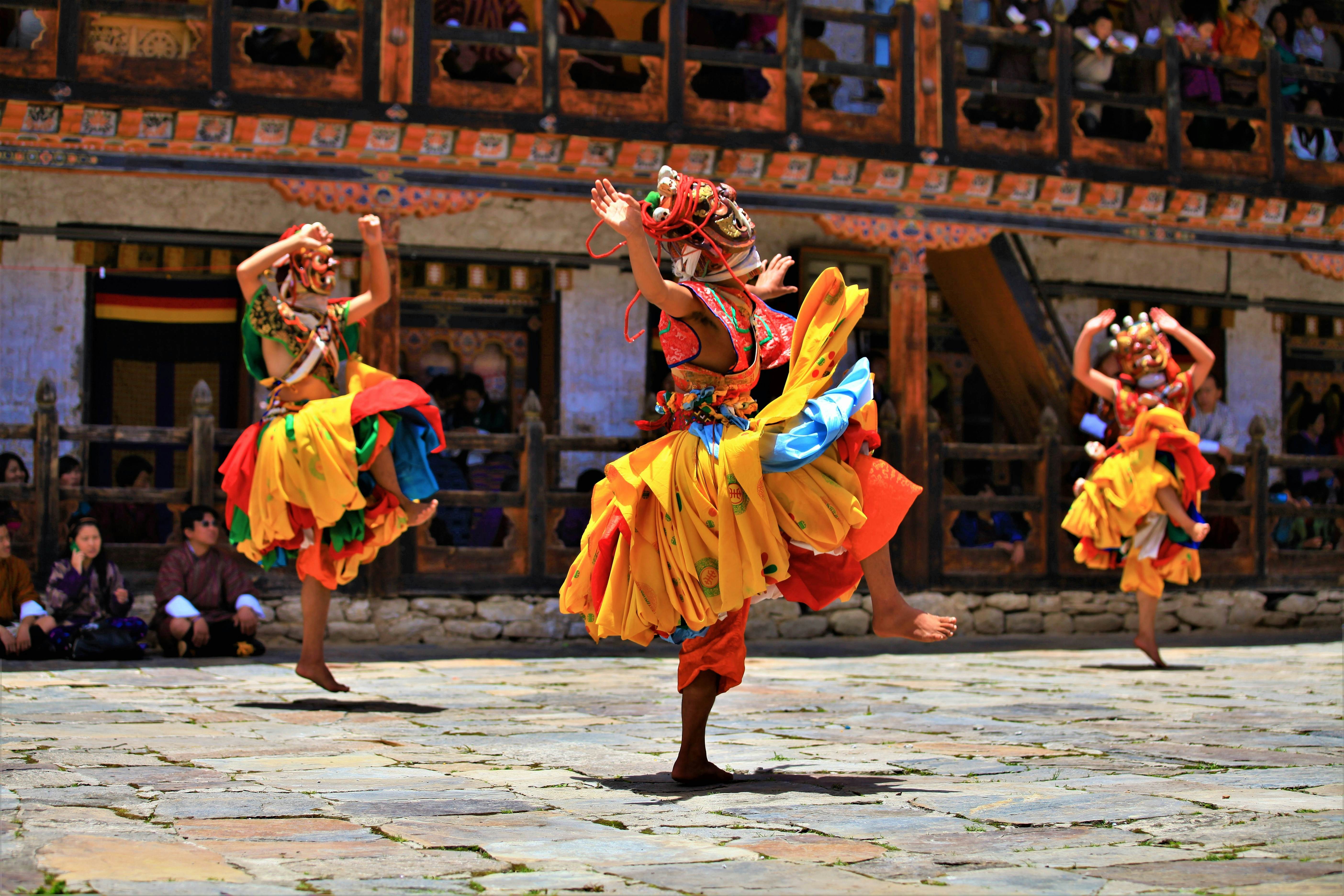 Monks wearing brightly colored costumes dance in a festival
Monks wearing brightly colored costumes dance in a festival
4. What Airlines Fly to Bhutan?
Bhutan is served by two national airlines: Drukair and Bhutan Airlines. Because of the challenging landing conditions at Paro International Airport, surrounded by peaks as high as 5500m (18,000ft), only a select few pilots are authorized to fly there. Direct flights to and from Paro connect you to various destinations, including Bangladesh (Dhaka), India (Bagdogra, Guwahati, Kolkata and New Delhi), Nepal (Kathmandu), Singapore, Thailand (Bangkok) and the UAE (Sharjah). Kathmandu promises the most epic route, with glimpses of Mt Everest on clear days.
Key Flight Considerations:
- Limited Airlines: Only Drukair and Bhutan Airlines operate flights to Paro.
- Direct Flights: Connections available from major Asian cities.
- Kathmandu Route: Offers stunning views of Mt. Everest on clear days.
- Luggage: Check luggage before boarding your Bhutan connection.
- Overland Travel: Reach Bhutan via India, but not China, owing to border disputes.
5. Is Bhutan Truly Carbon-Negative?
Bhutan is the world’s first carbon-negative country. Being roughly the same size as Switzerland with only 10% of its population, a key factor in sustaining this achievement is a landmark constitutional mandate requiring the country to maintain a minimum of 60% forest coverage at all times. This is also supported by the environmental conservation pillar of GNH.
Environmental Initiatives:
- Forest Coverage: Mandated minimum of 60% forest coverage.
- Plastic Ban: Implemented in 1999 to reduce waste.
- GNH Philosophy: Environmental conservation pillar supports sustainability.
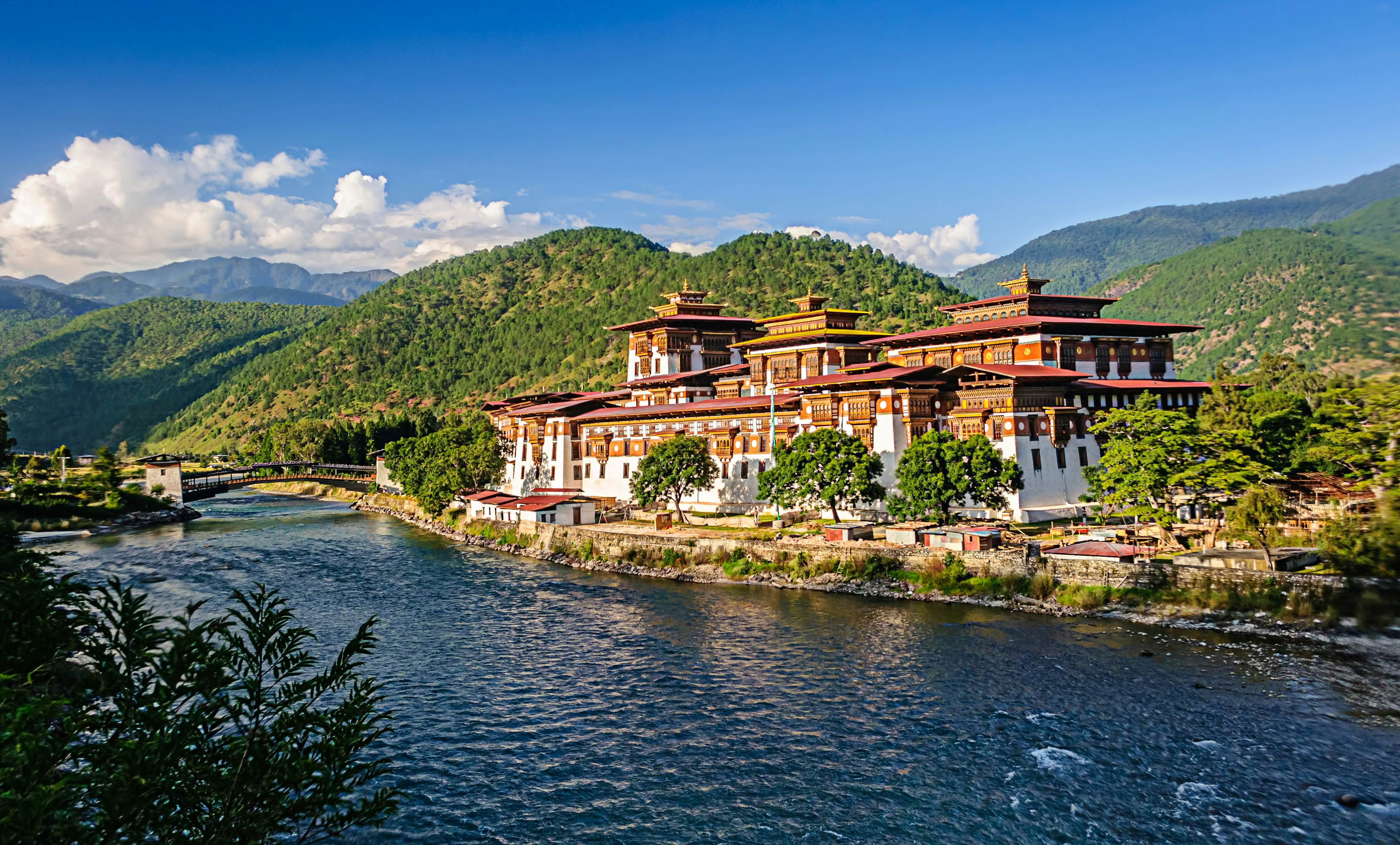 A riverside fortress surrounded by woodland
A riverside fortress surrounded by woodland
6. How Safe Is Bhutan for Tourists?
Bhutan maintains a low crime rate, with violent crime being scarce. As a single woman, I never felt unsafe on any of my trips to Bhutan. I was also never truly “alone” since I was always under the watchful eye of my guide or local friends. In recent years, the number of female guides has increased, which is more good news for solo women travelers.
Safety Tips for Travelers:
- Low Crime Rate: Violent crime is rare.
- Reliable Guides: Local guides provide safety and support.
- Solo Female Travel: Bhutan is considered safe for solo female travelers.
7. Are Vaccinations Required for Bhutan?
No vaccines are required for entry into Bhutan. That said, you should stay up-to-date with your vaccines and consult a health-care professional at least eight weeks before your departure in case you need any boosters. Standard recommendations include vaccinations for hepatitis A and B, diphtheria, tetanus and typhoid, in addition to childhood vaccinations for measles-mumps-rubella and polio.
Recommended Vaccinations:
- Hepatitis A and B
- Diphtheria, Tetanus, and Typhoid
- Childhood Vaccinations (Measles-Mumps-Rubella, Polio)
- Japanese Encephalitis and Rabies (for longer trips)
8. How to Minimize Altitude Sickness in Bhutan?
Acute Mountain Sickness (AMS) can occur when travelers are above 2500m (8202ft). Given that the most commonly visited cities – Thimphu and Paro – are just 200m to 300m (656ft to 984ft) below that threshold, and that several treks in the Bhutanese Himalayas traverse mountain passes reaching heights of 5000m (16,404ft), AMS is a risk in Bhutan.
Strategies to Prevent AMS:
- Ascend Slowly: Allow your body to adjust to the altitude.
- Take Rest Days: Incorporate rest days into your itinerary.
- Monitor Symptoms: Pay close attention to how you’re feeling.
- Descend if Needed: If symptoms worsen, descend immediately.
- Acclimatization: Spend a few days at a lower altitude before trekking.
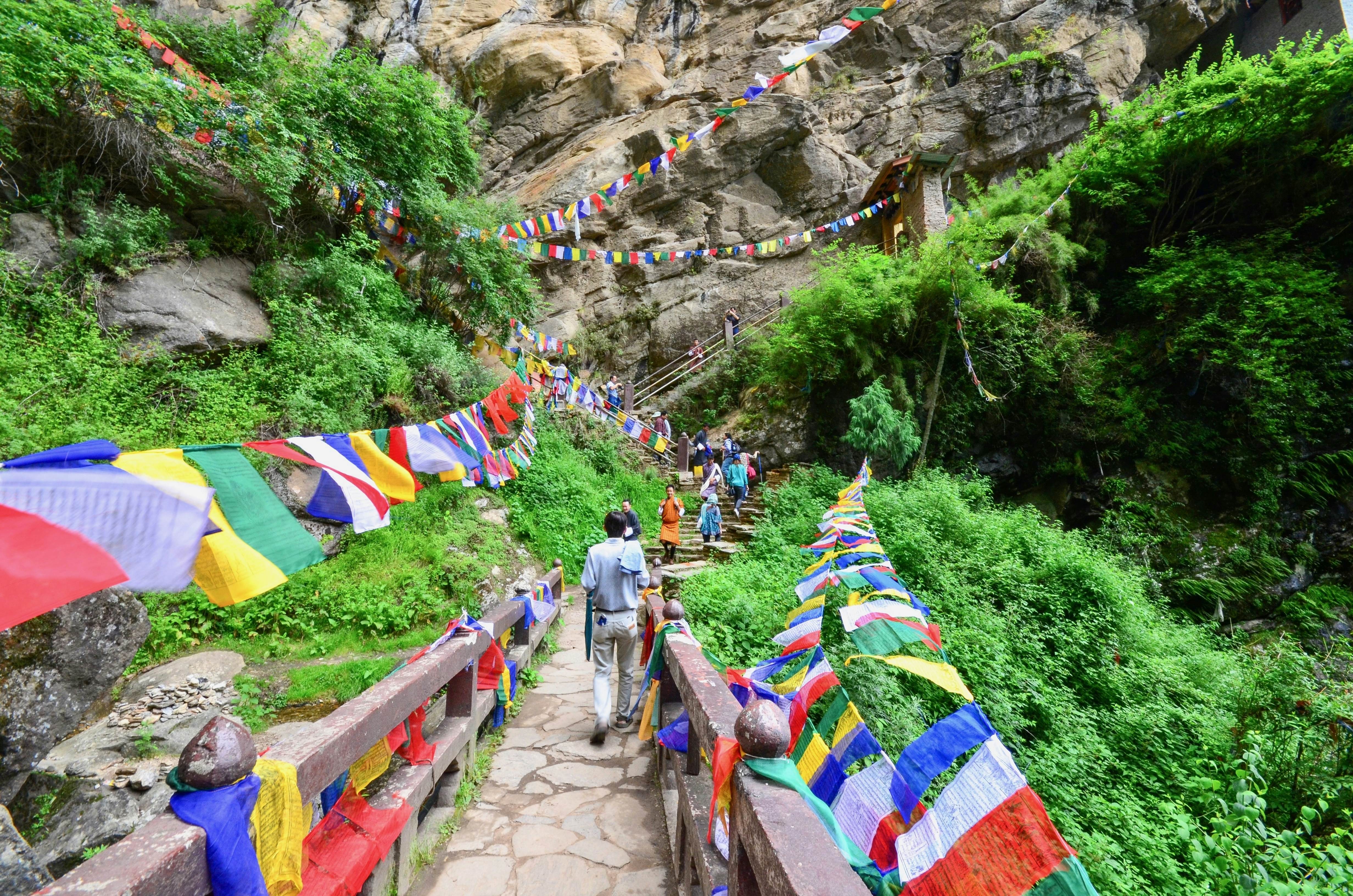 Pilgrims follow a path lined with prayer flags leading up to a series of stairs built into a rocky cliff face
Pilgrims follow a path lined with prayer flags leading up to a series of stairs built into a rocky cliff face
9. What Medical Essentials Should I Pack for Bhutan?
Bring insect repellent to protect yourself from mosquito-borne illnesses when visiting in the summer months and in the southern regions. Because of climate change, Bhutan had its first nation-wide dengue epidemic in 2019. Dengue is deadly, and there is no vaccine to protect against it. The risk of contracting malaria in Bhutan is low.
Essential Items:
- Insect Repellent: Protection against mosquito-borne illnesses like dengue.
- Sunscreen: Strong sun due to high altitude.
- Sunglasses: Protect eyes from intense sunlight.
- Dramamine: Car sickness medication for windy mountain roads.
- Diamox: Altitude sickness medication.
- Personal Hygiene: Diapers or tampons if needed.
10. What Is the Healthcare System Like in Bhutan?
Bhutan is sometimes called “Menjong,” which means “Land of Medicinal Herbs.” If you do find yourself feeling unwell during your trip, one option is a visit to Thimphu’s National Institute of Traditional Medicine. A member of staff will assess your pulse, temperature and ask about your bowels. In turn, you’ll receive a prescription for ayurvedic medicine crafted from local plants, all at no cost (a small donation is appreciated).
Healthcare Options:
- Traditional Medicine: Visit the National Institute of Traditional Medicine in Thimphu.
- Western Medicine: Hospitals and health clinics available.
- National Referral Hospital: Jigme Dorji Wangchuck National Referral Hospital in Thimphu.
11. What Should I Know About Bhutanese Food?
For decades, Bhutanese cuisine suffered in reputation because travelers were mostly exposed to mediocre buffets at their three-star hotels, featuring Indian, Chinese and continental dishes tailored precisely to their palates. Thankfully, those buffets are slowly being phased out. The local cuisine, emphasizing fresh and seasonal ingredients, is on the up and up and proving to be extremely tasty, if you know where to go. Ask your tour operator or guide for recommendations. And while Bhutanese cuisine is defined by hot chili peppers, such as with ema datse (chilies with cheese) and kewa datse (potatoes, chilies and cheese), dishes can be modified according to your taste if requested in advance.
Culinary Tips:
- Local Cuisine: Emphasizes fresh, seasonal ingredients.
- Spicy Dishes: Defined by hot chili peppers like ema datse and kewa datse.
- Customization: Dishes can be modified to your taste.
 A top-down view of pan of chilies and cheese, or ema datse, the national dish of Bhutan
A top-down view of pan of chilies and cheese, or ema datse, the national dish of Bhutan
12. Is Tap Water Safe to Drink in Bhutan?
Tap water isn’t safe to drink in Bhutan unless it has been boiled or purified. Ask your hotel or guesthouse for boiled water, or purchase bottled water to have on your person.
Hydration Advice:
- Avoid Tap Water: Unless boiled or purified.
- Boiled Water: Request from hotels or guesthouses.
- Bottled Water: Purchase for personal use.
13. What Are Some Important Local Customs and Etiquette Tips?
“Kuzu zangpo la” means “hello” in Dzongkha, a Sino-Tibetan language and the national language of Bhutan, most commonly spoken in the western part of the country. Recite this while bowing (shaking hands is less common). The deeper the bow, the greater the respect.
Cultural Etiquette:
- Dzongkha Greeting: “Kuzu zangpo la” (hello).
- Bowing: More common than shaking hands.
- Language: English is widely spoken.
- Offerings: Tradition dictates that you say the words “meshu meshu” while covering your mouth with your hands when invited into someone’s home and offered food
- Tipping: Consider giving a small tip if someone has invited you into their home and served you food or arra, a local spirit distilled from rice.
14. Is Tipping Expected in Bhutan?
Even if you’ve paid in advance for your all-inclusive trip, show appreciation to your guide and driver by tipping them at the end. On a trek, extend this gesture to the crew – ie the cook and any helpers. While 10–15% is normal, the amount and currency are up to you. Tipping is not necessary at restaurants and hotels. A 10% service charge is already added to your bill when you dine out.
Tipping Guidelines:
- Guides and Drivers: Tipping is appreciated.
- Trekking Crew: Extend tips to cooks and helpers.
- Restaurants and Hotels: A 10% service charge is usually included.
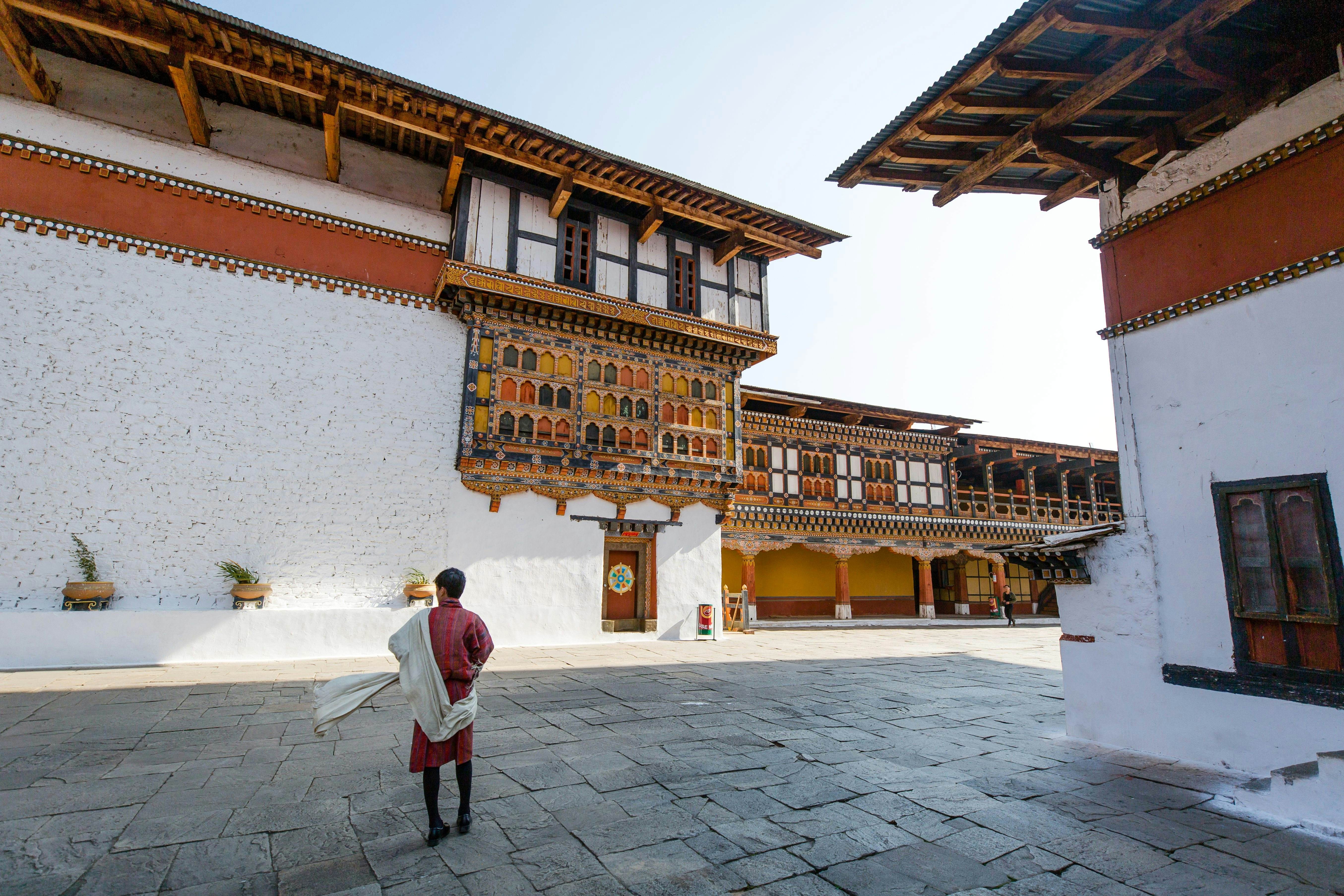 A guide in traditional Bhutanese dress walks through a monastery courtyard
A guide in traditional Bhutanese dress walks through a monastery courtyard
15. What Is the Nightlife Like in Thimphu?
While most people are drawn to Bhutan for its serene landscapes, peaceful Buddhist monasteries and imposing fortresses (dzongs) such as Punakha Dzong, the country is hiding a buzzing nightlife and music scene equally worth exploring.
Nightlife Spots:
- Chang Lam: Near the stadium.
- Zone: Popular bar.
- Mojo Park: Music venue.
- The Grey Area: Bhutan’s first gastropub.
- Space 34 and Vivacity: Nightclubs.
16. Is Smoking Allowed in Bhutan?
Bhutan was long known for its drastic yet visionary health law that forbade smoking and the trade of tobacco products. While the law was reversed in 2021, smoking must be done “out of sight,” ie behind buildings. The same goes for vaping. Vaping products are sold in a few places in Thimphu, but they’re not widely available.
Smoking Regulations:
- Smoking Allowed: But must be done out of sight.
- Vaping: Products are limited.
- Cannabis: Illegal, possession can lead to jail time.
17. What Should I Know About Local Beliefs?
Whether it’s migoi (yeti) sightings in Bhutan’s wild east, the significance of phalluses as symbols of protection or the flying tiger bringing Guru Rinpoche to the cave where the gravity-defying Tiger’s Nest Monastery now stands, folktales, myths and legends are an integral part of Bhutan’s culture and national pride – and believed to be true. Approach Bhutan with an open mind.
Understanding Local Beliefs:
- Folktales and Myths: Integral part of Bhutanese culture.
- Open Mind: Be respectful and suspend preconceptions.
18. What Should I Pack for a Trip to Bhutan?
You’ll want layers for fluctuating temperatures and varying terrains, and modest clothing for entering temples and monasteries, including socks for cold temple floors. Aside from a good pair of hiking boots, bring a nicer shoe to wear with a gho or kira (Bhutanese national dress for men and women, respectively), should you decide to buy an outfit – highly recommended if you’re attending a festival or meeting with a dignitary.
Essential Packing Items:
- Layers: For fluctuating temperatures.
- Modest Clothing: Cover shoulders and knees for religious sites.
- Hiking Boots: For trekking.
- Dress Shoes: For festivals or formal events.
 A large white chorten (stone Buddhist monument) with a gold pointed top
A large white chorten (stone Buddhist monument) with a gold pointed top
19. How Should I Handle Money in Bhutan?
It’s easier to bring your own money (make sure the bills are crisp) rather than rely on and seek out ATM machines in the country. The official currency in Bhutan is the ngultrum, which is pegged 1:1 to the Indian rupee. Exchange at a bank or hotel so that you have small ngultrum notes for butter-lamp offerings, donations at religious sites, buying souvenirs, and tipping your guide, driver and trekking crew.
Money Tips:
- Bring Cash: Crisp bills are preferred.
- Local Currency: Ngultrum (pegged 1:1 to the Indian rupee).
- Exchange Money: At banks or hotels.
- Digital Payment: Most Bhutanese businesses accept cash or payments through either goBoB or the BNB MyPay apps
20. Should I Get a Local SIM Card in Bhutan?
SIM cards used to be challenging to obtain, but now you can easily get them upon arrival at Paro International Airport. You can also rent a pocket wi-fi device there – useful if you’re planning to visit remote regions and need to be online.
Connectivity Solutions:
- SIM Card: Available upon arrival at Paro Airport.
- Pocket Wi-Fi: Rent for remote regions.
21. What Is the Proper Etiquette at Religious Sites in Bhutan?
When visiting Buddhist monasteries, nunneries and temples, observe proper etiquette: remove shoes and hats, wear clothing that covers your shoulders and knees, refrain from photography in altar rooms, avoid pointing, never lean against a stupa and consider leaving a small donation on the altar or with a monk. If seeking a blessing, it’s customary to offer a small donation.
Religious Site Etiquette:
- Remove Shoes and Hats
- Dress Modestly
- No Photography in Altar Rooms
- Avoid Pointing
- Do Not Lean Against Stupas
- Offer Donations
- Circumambulation: Walk around shrines clockwise.
- Prayer Wheels: Spin in a clockwise direction.
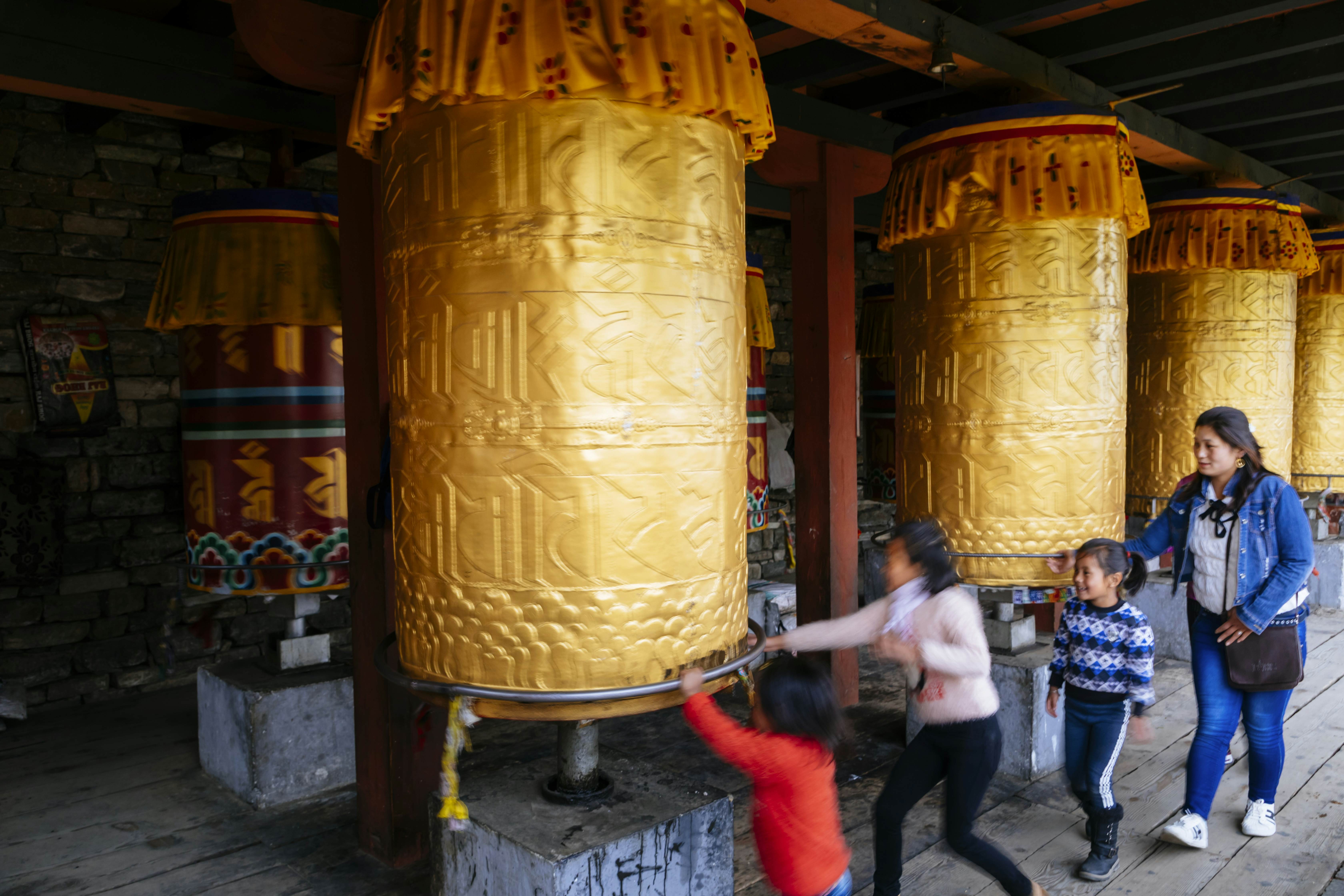 A woman and three young children spinning a prayer wheel in a monastery
A woman and three young children spinning a prayer wheel in a monastery
22. Is Bargaining Acceptable in Bhutan?
Unlike some other places in Asia where you’re expected to haggle, Bhutan’s market scene is a lot more straightforward. You typically pay the price that’s listed – aggressive negotiating tactics are a foreign concept.
Shopping Advice:
- Fixed Prices: Haggling is not common.
- Textiles: High-quality, handcrafted items.
23. How Does the Lunar Calendar Affect Travel Plans in Bhutan?
Since Bhutan follows the lunar calendar, dates for Buddhist festivals, like tsechus, change from year to year. However, some cultural festivals, like Bhutan National Day and the Black Necked Crane Festival in Phobjikha Valley, follow the Gregorian calendar and therefore stay the same.
Calendar Considerations:
- Lunar Calendar: Affects festival dates.
- Gregorian Calendar: Some festivals remain consistent.
FAQ: Traveling to Bhutan
1. Do I need a visa to travel to Bhutan?
Yes, all travelers except Indian passport holders need a visa to enter Bhutan. SIXT.VN can assist with your visa application process.
2. How much does it cost to travel to Bhutan?
Bhutan used to have a Sustainable Daily Fee (SDF) but it has been reduced to US$100 (valid until August 2027) and no longer requires travelers to book an exorbitant all-inclusive tour package. There is also a 50% discount on SDF for kids ages six to 11, with no SDF for those under six. A one-time US$40 visa-application fee also applies.
3. What is the best way to get around in Bhutan?
The best way to get around in Bhutan is by hiring a private car with a driver. SIXT.VN offers convenient and reliable transportation services.
4. What are the must-see attractions in Bhutan?
Must-see attractions in Bhutan include the Tiger’s Nest Monastery, Punakha Dzong, and Buddha Dordenma. SIXT.VN can arrange guided tours to these iconic sites.
5. Can I use my credit card in Bhutan?
Credit card acceptance is limited in Bhutan. It’s recommended to carry cash, especially in smaller towns and rural areas.
6. What is the local language in Bhutan?
The local language in Bhutan is Dzongkha. English is also widely spoken, especially in tourist areas.
7. What is the time zone in Bhutan?
Bhutan Standard Time (BST) is UTC+6, which is six hours ahead of Coordinated Universal Time.
8. Are there any cultural sensitivities I should be aware of?
Yes, it’s important to dress modestly when visiting religious sites, walk around temples and chortens clockwise, and avoid pointing your feet at people or sacred objects.
9. What kind of electricity plugs are used in Bhutan?
Bhutan uses Type D and Type F electrical plugs. It’s advisable to bring a universal adapter.
10. Is it safe to eat street food in Bhutan?
While street food options are limited, it’s generally safe to eat at established restaurants and hotels. Always ensure the food is freshly prepared and hygienic.
Experience Bhutan with SIXT.VN
Ready to embark on your adventure to Bhutan? SIXT.VN offers a range of services to make your trip seamless and unforgettable:
- Customized Tour Packages: Tailored itineraries to suit your interests and preferences.
- Airport Transfers: Convenient and reliable transportation from Paro International Airport.
- Hotel Bookings: Handpicked accommodations to ensure comfort and convenience.
- Guided Tours: Expert local guides to enhance your exploration of Bhutan’s attractions.
- Visa Assistance: Support with your visa application process.
Contact SIXT.VN today to start planning your dream trip to the Land of the Thunder Dragon!
Address: 260 Cau Giay, Hanoi, Vietnam
Hotline/WhatsApp: +84 986 244 358
Website: SIXT.VN



